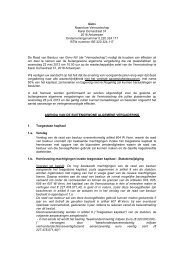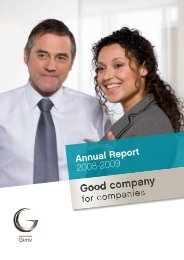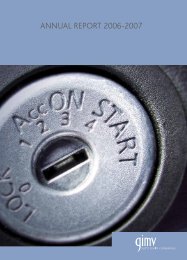ANNUAL REPORT 2007 | 2008 - Gimv
ANNUAL REPORT 2007 | 2008 - Gimv
ANNUAL REPORT 2007 | 2008 - Gimv
You also want an ePaper? Increase the reach of your titles
YUMPU automatically turns print PDFs into web optimized ePapers that Google loves.
Current liabilities rose by almost half to EUR 161.0 million, mainly<br />
due to a EUR 17.0 million increase in short-term fi nancial liabilities<br />
and a EUR 29.8 million rise in trade and other payables.<br />
Here too, short-term fi nancial liabilities stand in sharp contrast<br />
to the total absence of current fi nancial liabilities in the limited<br />
consolidation, for the same reasons as given above.<br />
Principal risks and uncertainties<br />
Credit risk<br />
The fi nancial assets consist mainly of unguaranteed investments<br />
in unlisted companies. The Board of Directors views the<br />
maximum credit risk as being the total value of the portfolio.<br />
The diversity of the portfolio allows the investment manager to<br />
control the credit risk by taking into account the specifi c features<br />
of the underlying assets.<br />
Liquidity risk<br />
Given its balance sheet structure the <strong>Gimv</strong> group, excluding the<br />
buy-outs included in the consolidation, has a very positive net<br />
cash position. There are therefore no risks related to fi nancings.<br />
The buy-outs included in the consolidation do have debts, for<br />
which the <strong>Gimv</strong> group has not given any joint and liable guarantee.<br />
<strong>Gimv</strong> does keep watch, however, to ensure that these<br />
buy-out companies build in suffi cient margin and do not incur<br />
any liabilities which could exceed their expected repayment<br />
capacities in normal circumstances. Given this situation, the<br />
Board of Directors views the liquidity risk as limited.<br />
Price risk<br />
The valuation of the unlisted investments depends on a number<br />
of market-related elements and the results of the enterprises in<br />
question. <strong>Gimv</strong> does not hedge the market risk inherent in the<br />
portfolio, but manages the risks specifi c to each investment.<br />
Interest risk<br />
Interest on outstanding mezzanine instruments is almost always<br />
fi xed for the entire life of the loan. The market interest rate can,<br />
though, have a signifi cant impact on the valuation of the buyout<br />
portfolio, given that these are mostly leveraged buy-outs.<br />
This risk is part of the business risk, along with the results<br />
of the shareholdings themselves and the available fi nancing<br />
possibilities.<br />
Market risk<br />
Given that the <strong>Gimv</strong> group reports its fi nancial assets at market<br />
value, there is no difference between the reported carrying<br />
value and market value.<br />
Signifi cant events after balance sheet closing date<br />
In mid-May, <strong>Gimv</strong> sold its shareholding in Westerlund Group, a<br />
Belgian logistics company that specializes in wood products, to<br />
international investment and consulting fi rm Babcock & Brown.<br />
This sale adds EUR 9.2 million (EUR 0.40 per share) to the<br />
value of <strong>Gimv</strong>’s equity at 31 March <strong>2008</strong>.<br />
<strong>Gimv</strong> has also made a USD 7 million follow-up investment in<br />
CoreOptics, a German-US company in the optical networks sector.<br />
Finally, EUR 3 million has been invested in Openbravo, a<br />
Spanish company that develops open-source ERP software.<br />
Outlook<br />
The earnings of <strong>Gimv</strong> as an investment company are dependent<br />
on the evolution of the value of the companies in which <strong>Gimv</strong><br />
participates. Given that this value is dependent on various factors,<br />
like the evolution of fi nancial markets, it is impossible to<br />
make any realistic statement as to the prospects of the group.<br />
Research and development<br />
<strong>Gimv</strong> and its consolidated subsidiaries did not undertake any<br />
research and development activities during the past year.<br />
Financial risks and the use of fi nancial instruments<br />
Currency hedging<br />
Without the buy-outs the <strong>Gimv</strong> group had on 31 March <strong>2008</strong><br />
a currency risk of EUR 111 064 (USD 138 899, GBP 12 978<br />
and CHF 10 793). <strong>Gimv</strong> is aiming to hedge the currency risk on<br />
the USD in full in an appropriate way in the longer term. With<br />
this intention, <strong>Gimv</strong> carried out between 2005 and <strong>2008</strong> various<br />
hedging operations covering the period 2006 to 2010. On<br />
31 March <strong>2008</strong>, USD 65 300 (47 percent of the USD risk) was<br />
covered by a combination of various instruments. These hedges<br />
produced a positive result of EUR 4 741. In the buy-outs, foreign<br />
exchange contracts are concluded to cover purchasing and<br />
sales transactions. Interest rate risks on loans are hedged.<br />
Financial instruments are used by <strong>Gimv</strong> to cover risks that are<br />
not part of <strong>Gimv</strong>’s core activities.<br />
On behalf of the Board of Directors, 20 May <strong>2008</strong><br />
Herman Daems and Leo Victor, director.<br />
| 149





